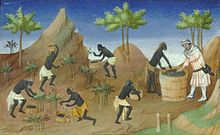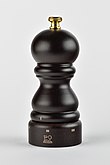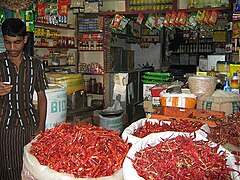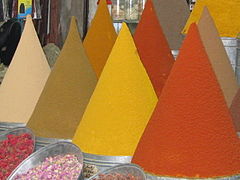Spice
In the
Spices may be used fresh and whole, after drying, grating, chopping, crushing, or grinding, or by extraction into a tincture. Such processing may happen before a spice is offered for sale, while preparing a dish in a kitchen, or after a dish has been presented for consumption (such as peppercorns ground at the table as a condiment). Some spices such as turmeric are seldom available either fresh or whole and so must be purchased in ground form. Small seeds such as fennel or mustard may be used either whole or in powdered form.
A whole dried spice has the longest shelf life, so it can be purchased and stored in larger amounts, making it cheaper on a per-serving basis. A fresh spice, such as ginger, is usually more flavorful than its dried form, but fresh spices are more expensive and have a much shorter shelf life.
There is not enough clinical evidence to indicate that consuming spices affects human health.[3]
India contributes to 75% of global spice production.[citation needed] This is reflected culturally through its cuisine. Historically, the spice trade developed throughout the Indian subcontinent as well as in East Asia and the Middle East. Europe's demand for spices was among the economic and cultural factors that encouraged exploration in the early modern period.
Etymology
The word spice originated in Middle English,[4] from the Old French words espece, espis(c)e, and espis(c)e.[5] According to the Middle English Dictionary, the Old French words came from Anglo-French spece;[5] according to Merriam Webster, the Old-French words came from Anglo-French espece, and espis.[4] Both publications agree that the Anglo-French words are derived from Latin species.[4][5] Middle English spice had its first known use as a noun in the 13th century.[4]
History
Early history
The spice trade developed throughout the Indian subcontinent[6] and Middle East by 2000 BCE with cinnamon and black pepper, and in East Asia with herbs and pepper. The Egyptians used herbs for cuisine and mummification. Their demand for exotic spices and herbs helped stimulate world trade.
Cloves were used in Mesopotamia by 1700 BCE.[note 1] The earliest written records of spices come from ancient Egyptian, Chinese, and Indian cultures. The Ebers Papyrus from early Egypt dating from 1550 BCE describes some eight hundred different herbal medicinal remedies and numerous medicinal procedures.[10]
By 1000 BCE, medical systems based upon herbs could be found in China, Korea, and India.[citation needed] Early uses were associated with magic, medicine, religion, tradition, and preservation.[11]
Indonesian merchants traveled around China, India, the Middle East, and the east coast of Africa.
Spices were prominent enough in the ancient world that they are mentioned in the
The ancient Indian epic Ramayana mentions cloves.
Historians believe that nutmeg, which originates from the Banda Islands in Southeast Asia, was introduced to Europe in the 6th century BCE.[12] The Romans had cloves in the 1st century CE, as Pliny the Elder wrote about them.[13]
Middle Ages

Spices were among the most demanded and expensive products available in Europe in the
Spices were all imported from plantations in Asia and Africa, which made them expensive. From the 8th until the 15th century, the
Early modern period
Voyagers from Spain and Portugal were interested in seeking new routes to trade in spices and other valuable products from Asia. The control of trade routes and the spice-producing regions were the main reasons that Portuguese navigator Vasco da Gama sailed to India in 1499.[8] When da Gama discovered the pepper market in India, he was able to secure peppers for a much cheaper price than the ones demanded by Venice.[15] At around the same time, Christopher Columbus returned from the New World. He described to investors the new spices available there.[18][a]
Another source of competition in the spice trade during the 15th and 16th centuries was the
With the discovery of the New World came new spices, including allspice, chili peppers, vanilla, and chocolate. This development kept the spice trade, with America as a latecomer with its new seasonings, profitable well into the 19th century.[citation needed]
Function

Spices are primarily used as food flavoring or to create variety.[20] They are also used to perfume cosmetics and incense. At various periods, many spices were used in herbal medicine. Finally, since they can be expensive, rare and exotic commodities, their conspicuous consumption has often been a symbol of wealth and social class.[17]
Preservative claim
The most popular explanation for the love of spices in the Middle Ages is that they were used to preserve meat from spoiling, or to cover up the taste of meat that had already gone off. This compelling but false idea constitutes something of an urban legend, a story so instinctively attractive that mere fact seems unable to wipe it out... Anyone who could afford spices could easily find meat fresher than what city dwellers today buy in their local supermarket.[17]
It is often claimed that spices were used either as food preservatives or to mask the taste of spoiled meat, especially in the European Middle Ages.[17][21] This is false.[22][23][24][17] In fact, spices are rather ineffective as preservatives as compared to salting, smoking, pickling, or drying, and are ineffective in covering the taste of spoiled meat.[17] Moreover, spices have always been comparatively expensive: in 15th century Oxford, a whole pig cost about the same as a pound of the cheapest spice, pepper.[17] There is also no evidence of such use from contemporary cookbooks: "Old cookbooks make it clear that spices weren't used as a preservative. They typically suggest adding spices toward the end of the cooking process, where they could have no preservative effect whatsoever."[25] Indeed, Cristoforo di Messisbugo suggested in the 16th century that pepper may speed up spoilage.[25]
Though some spices have antimicrobial properties in vitro,[26] pepper—by far the most common spice—is relatively ineffective, and in any case, salt, which is far cheaper, is also far more effective.[25]
Classification and types
Culinary herbs and spices
Botanical basis
- mustard, nutmeg, and black pepper
- Fruits, such as Cayenne pepper and Chimayo pepper
- mace(part of nutmeg plant fruit)
- cassia
- cloves
- Stigmas, such as saffron
- Roots and rhizomes, such as turmeric, ginger and galangal
- Resins, such as asafoetida
Common spice mixtures
- Advieh (Iran)
- Baharat (Arab world, and the Middle East in general)
- Berbere (Ethiopia, Eritrea and Somalia)
- Bumbu (Indonesia)
- Cajun (United States)
- Chaat masala (Indian subcontinent)
- Chili powder and crushed red pepper (Cayenne, Chipotle, Jalapeño, New Mexico, Tabasco, and other cultivars)
- Curry powder
- Five-spice powder (China)
- Garam masala (Indian subcontinent)
- Harissa (North Africa)
- Hawaij (Yemen)
- Jerk spice (Jamaica)
- Khmeli suneli (Georgia, former U.S.S.R.)
- Masala(a generic name for any mix used in the Indian subcontinent)
- Mixed spice (United Kingdom)
- Panch phoron (Indian subcontinent)
- Pumpkin pie spice (United States)
- Quatre épices (France)
- Ras el hanout (North Africa)
- Sharena sol (literally "colorful salt", Bulgaria)
- Shichimi tōgarashi (Japan)
- Speculaas (Belgium and Netherlands)
- Thuna Paha (Sri Lanka)
- Vegeta (Croatia)
- Za'atar (Middle East)
Handling


A mortar and pestle is the classic set of tools for grinding a whole spice. Less labor-intensive tools are more common now: a microplane or fine grater can be used to grind small amounts; a coffee grinder[note 2] is useful for larger amounts. A frequently used spice such as black pepper may merit storage in its own hand grinder or mill.
The flavor of a spice is derived in part from compounds (volatile oils) that
Some flavor elements in spices are soluble in water; many are soluble in oil or fat. As a general rule, the flavors from a spice take time to infuse into the food so spices are added early in preparation. This contrasts to herbs which are usually added late in preparation.[27]
Salmonella contamination
A study by the Food and Drug Administration of shipments of spices to the United States during fiscal years 2007–2009 showed about 7% of the shipments were contaminated by Salmonella bacteria, some of it antibiotic-resistant.[28] As most spices are cooked before being served salmonella contamination often has no effect, but some spices, particularly pepper, are often eaten raw and are present at the table for convenient use. Shipments from Mexico and India, a major producer, were the most frequently contaminated.[29] Food irradiation is said to minimize this risk.[30][31]
Production

| Rank | Country | 2010 | 2011 |
|---|---|---|---|
| 1 | India | 1,474,900 | 1,525,000 |
| 2 | Bangladesh | 128,517 | 139,775 |
| 3 | Turkey | 107,000 | 113,783 |
| 4 | China | 90,000 | 95,890 |
| 5 | Pakistan | 53,647 | 53,620 |
| 6 | Iran | 18,028 | 21,307 |
| 7 | Nepal | 20,360 | 20,905 |
| 8 | Colombia | 16,998 | 19,378 |
| 9 | Ethiopia | 27,122 | 17,905 |
| 10 | Sri Lanka | 8,293 | 8,438 |
| — | World | 1,995,523 | 2,063,472 |
| Source: UN Food & Agriculture Organization[32]
| |||
Standardization
The International Organization for Standardization addresses spices and condiments, along with related food additives, as part of the International Classification for Standards 67.220 series.[33]
Gallery
-
The Gato Negro café and spice shop (Buenos Aires, Argentina)
-
A spice shop selling a variety of spices in Iran
-
Night spice shop in Casablanca, Morocco
-
A spice shop in Taliparamba, India
-
Spices sold in Taliparamba, India
-
Spice seller at a market in Kashgar, China
-
Spice market, Marrakesh, Morocco
See also
Notes
- ^ A team of archaeologists led by Giorgio Buccellati excavating the ruins of a burned-down house at the site of Terqa, in modern-day Syria, found a ceramic pot containing a handful of cloves. The house had burned down around 1720 BC and this was the first evidence of cloves being used in the west before Roman times.[7][8][9]
- ^ Other types of coffee grinders, such as a burr mill, can grind spices just as well as coffee beans.
- ^ Nutmeg, in particular, suffers from grinding and the flavor will degrade noticeably in a matter of days.
- ^ Light contributes to oxidation processes.
- ^ The word "ají" is still used in South American Spanish for chili peppers.
References
- ^ "Spice and herb | Types, Uses, & Facts | Britannica". www.britannica.com. March 8, 2024. Retrieved April 9, 2024.
- S2CID 241855294.
- PMID 31143299.
- ^ a b c d "Definition of SPICE". Merriam-Webster. Archived from the original on August 12, 2022. Retrieved August 12, 2022.
- ^ a b c "spice - Middle English Compendium". quod.lib.umich.edu. Archived from the original on August 12, 2022. Retrieved August 12, 2022.
- ISBN 978-0-520-30338-6. Archivedfrom the original on June 30, 2023. Retrieved April 13, 2019.
- ^ Daniel T. Potts (1997), Mesopotamian Civilization: The Material Foundations. Archived March 26, 2023, at the Wayback Machine A&C Black publishers, p. 269
- ^ Buccellati, G., M. Kelly-Buccellati, Terqa: The First Eight Seasons, Les Annales Archeologiques Arabes Syriennes 33(2), 1983, 47-67
- ISBN 978-1-68177-152-6.
- ^ Woodward, Penny (2003). "Herbs and Spices". In Katz (ed.). Encyclopedia of Food and Culture. Vol. 2. Charles Scribner's Sons. pp. 187–195.
- ^ ISBN 978-0-9704285-0-9.
- ^ Burkill, I.H. (1966). A Dictionary of the Economic Products of the Malay Peninsula. Kuala Lumpur: Ministry of Agriculture and Co-Operatives.
- ISBN 978-1-4200-4048-7. Archivedfrom the original on June 30, 2023. Retrieved May 9, 2017.
- from the original on June 30, 2023. Retrieved December 4, 2022.
- ^ PMID 25450779.
- ISBN 978-0-313-32147-4.
- ^ ISBN 9780300151350, p. 2-3
- ^ Turner, 2004, p. 11
- ISBN 978-0-470-39130-3
- ^ Dennett, Carrie (January 26, 2017). "How a full spice cabinet can keep you healthy". The Washington Post. Archived from the original on February 8, 2023. Retrieved August 12, 2022.
- PMID 25568057.
- ISBN 1847888097, p. 24
- ISBN 0520236742, p. 156
- ISBN 1441159916, p. 170
- ^ ISBN 9780345480835, p. 6
- .
- ^ a b Host: Alton Brown (January 14, 2004). "Spice Capades". Good Eats. Season 7. Episode 14. Food Network.
- from the original on June 16, 2019. Retrieved June 16, 2019.
Shipments of imported spices offered for entry to the United States were sampled during the fiscal years 2007–2009. The mean shipment prevalence for Salmonella was 0.066 (95% CI 0.057–0.076)
- ^ Gardiner Harris (August 27, 2013). "Salmonella in Spices Prompts Changes in Farming". The New York Times. Archived from the original on August 29, 2013. Retrieved August 28, 2013.
- PMID 12568551.
- ^ "Myths about Food Irradiation". Center for Consumer Research. June 28, 2017. Archived from the original on July 30, 2022. Retrieved July 30, 2022.
- UN Food & Agriculture Organization. 2011. Archived from the originalon July 13, 2011. Retrieved December 20, 2013.
- ^ "67.220: Spices and condiments. Food additives". International Organization for Standardization. 2009. Archived from the original on June 6, 2011. Retrieved April 23, 2009.
Further reading
Books
- Czarra, Fred (2009). Spices: A Global History. Reaktion Books. p. 128. ISBN 978-1-86189-426-7.
- ISBN 978-0-520-23674-5.
- ISBN 978-0-300-21131-3.
- ISBN 978-0-7195-6199-3.
- Krondl, Michael (2008). The Taste of Conquest: The Rise and Fall of the Three Great Cities of Spice. Random House. ISBN 978-0-345-50982-6.
- Miller, James Innes (1969). The spice trade of the Roman Empire, 29 B.C. to A.D. 641. Oxford: Clarendon P. ISBN 978-0-19-814264-5.
- Morton, Timothy (2006). The Poetics of Spice: Romantic Consumerism and the Exotic. Cambridge University Press. ISBN 978-0-521-02666-6.
- Seidemann, Johannes (2005). World Spice Plants: Economic Usage, Botany, Taxonomy. Springer. ISBN 978-3-540-22279-8.
- ISBN 978-0-375-40721-5.








